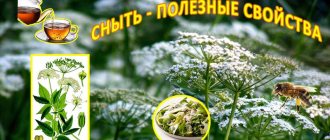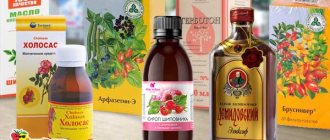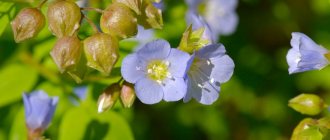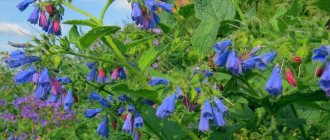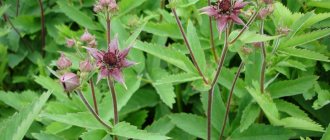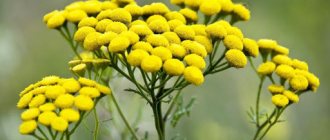Photo: UGC Shepherd's purse is a common weed that has been recognized as a medicinal plant since ancient times. It is used as a component of herbal medicines. Shepherd's purse herb is often used to prevent pathologies of the female reproductive system, as part of hemostatic drugs for internal and external bleeding. Let us consider in detail what is known about the herb shepherd's purse: description, benefits, medicinal properties and contraindications.
What does a shepherd's purse look like?
Appearance of a shepherd's purse.
Photo: Yandex.Pictures Shepherd's purse is an annual herb from the cruciferous (cabbage) family. It has an erect, single or branched stem with a height of 40 to 60 centimeters.
The basal leaves are large, elliptical in shape, entire, notched-toothed, turning into a petiole. The stem leaves are arrow-shaped, with smooth edges. The higher the leaves are, the smaller they become.
The flowers are small, unattractive, white. Located on spaced stalks, densely collected in an elongated raceme, greatly lengthening during fruiting.
Shepherd's purse blooms from early summer until late autumn. The fruits ripen at different times starting in May. The fruit is an inverse triangle-shaped pod with a heart-shaped notch on the upper side.
The shape of the fruit is reminiscent of the shoulder bags worn by Western European shepherds in the 18th century. This was the reason for the name of the plant.
The life cycle of the plant is short. Shepherd's purse is an extremely fruit-bearing and tenacious plant. Young shoots quickly turn into adult plants. In one summer, the grass can produce four generations, dispersing tens of thousands of seeds.
Seeds remain viable for up to six years. Plants that sprouted from seeds in late autumn do not die in winter, but continue to live in the spring of next year.
History of plant use
Although the plant is considered a malicious weed, this in no way detracts from its medicinal properties. They were known back in Ancient Greece and Rome. In Europe in the Middle Ages it was used as a hemostatic agent.
Interest in the plant arose again during the First World War, when the need for hemostatic agents increased sharply. The entire aerial part of the shepherd's purse is used in medicine.
You can cook green cabbage soup and borscht from young and fresh leaves of the herb. The plant is also suitable for preparing vitamin salads. Ground seeds can replace mustard or pepper.
Growing
Planting a shepherd's purse
The shepherd's purse flower is so widespread that it does not require special cultivation, but if you want to use it as food regularly, then try to collect the seeds of the plant during the summer. Shepherd's purse is sown in early spring: the plant has a rather long growing season, and with summer sowing, the plant will have time to produce flower stalks this year, but will not form rosettes. When sown in autumn, seedlings will appear next spring.
As soon as the snow melts, find a sunny or semi-shaded area in the garden with moist and nutritious soil and prepare it for planting as you prepare the soil for mustard greens or cabbage. Shepherd's bag seeds are mixed with sand in a ratio of 1:5 and sown over the surface of the plot in even rows located at a distance of 20-25 cm from each other. The top of the crops is only lightly sprinkled with earth. The first shoots may appear in 5-10 days.
- Sunflower: growing in the garden
Rules of care
Water the shepherd's purse only during prolonged drought. The plant does not require loosening the soil between the rows, and the grasshopper is fed once a season with complex mineral fertilizer for flowering plants, although this is not necessary. From time to time, it will be necessary to remove large weeds from the site that are blocking the plant from the sun. Shepherd's purse is resistant to diseases and pests of cabbage crops, but can suffer from cruciferous flea beetles and powdery mildew. Flea beetles can be eliminated by dusting the shepherd's bagworm with ash, and it is better to fight powdery mildew with folk remedies (mullein, ash infusion, soda ash solution) or biofungicides (Fitosporin-M, Alirin-B, Gamair, Planriz or Pseudobacterin-2).
Chemical composition
Basal leaves of shepherd's purse. Photo: Yandex.Pictures
- Carbohydrates and related compounds are found in the plant: sucrose, sorbose, lactose, sorbitol, mannitol, adonitol, aminosucrose.
- Shepherd's purse contains malic, citric, tartaric and organic acids, up to 3% tannins, saponins, bursin alkaloid and essential oil.
- Coumarins, flavonoids, choline, acetylcholine, tyramine, phytoncides, ascorbic acid, vitamin K, rutin, a lot of potassium and phosphorus, iron, copper, chromium, manganese, aluminum, cobalt, titanium were also found.
- The seeds of the plant are rich in fatty oils - from 28 to 30%. They also contain resins, small amounts of allyl mustard oil and ascorbic acid.
Medicinal use
- Shepherd's purse preparations are effective for various internal bleedings. They cause uterine contractions, lower blood pressure, and constrict peripheral blood vessels.
- Infusions of shepherd's purse stop diarrhea and increase urine output.
- In homeopathy, plant-based preparations are used for all types of bleeding and kidney diseases.
- In Indian medicine - as an astringent, diuretic, antiscorbutic. Shepherd's purse is used for hematuria, ascites, and diarrhea.
- Freshly ground herb is used for compresses for bruises.
- Preparations based on the plant have analgesic, wound healing, antiemetic and antitoxic effects. They enhance intestinal motility and have high phytoncidal activity.
- In Tibetan medicine, the herb is considered the best remedy for stopping hiccups.
- In scientific medicine, infusion and liquid extract of the plant are used in gynecological practice for uterine atony, as a sedative for neuropsychiatric diseases.
Shepherd's purse in folk medicine
Photo: Yandex.Pictures
- In folk medicine, shepherd's purse, its infusion and fresh juice are used for pulmonary hemorrhages, malignant ulcers and stomach cancer, tumors, cancer and uterine fibroids.
- The infusion helps with dysentery, gastritis, pulmonary tuberculosis, malaria, kidney diseases, gynecological diseases, and colds. The plant can be used to treat purulent wounds.
- Shepherd's purse extract accelerates blood clotting and delays ovulation.
- In folk medicine, freshly squeezed juice from the plant is drunk for kidney and bladder diseases.
- The juice of the herb neutralizes medicinal substances that accumulate in the body in chronic patients when taking medications for a long time. To cleanse the body, drink fresh herb juice 30–40 drops 3 times a day with water.
Contraindications
When using medicinal raw materials, it is important to consider the possible contraindications of shepherd’s purse:
- pregnancy;
- pathologies of the thyroid gland;
- excessive sensitivity to products made from this medicinal plant;
- thrombophlebitis;
- age below 18 years.
Medicinal herbs are prohibited after heart attacks. Caution is necessary when breastfeeding, the presence of kidney stones, and scanty menstruation. The plant should not be used in parallel with medications designed to thin the blood.
You should stop using the bagworm if, after carrying out therapeutic measures using products based on this plant, a skin rash, swelling, difficulty breathing, itching, rapid heartbeat, or intestinal upset appears.
Traditional medicine recipes
For medicinal purposes, shepherd's purse is used along with the stem, leaves, flowers and fruits.
Infusion for the treatment of bladder diseases
- Take 40–50 grams of raw shepherd's purse and pour a liter of boiling water. Wrap and leave for half an hour. Drink the infusion 2-3 times a day, 70 ml.
Hemostatic agent
- Pour one tablespoon of dry shepherd's purse herb into a glass of boiling water. Leave for two hours, strain. Take two tablespoons 4 times a day.
- Liquid extract of shepherd's purse herb (pharmacy) take 25 drops 4-5 times a day.
For liver diseases
- Shepherd's purse, its fresh juice helps with liver diseases and malignant ulcers. For medicinal purposes, it is recommended to take fresh herb juice 40 drops with water 3 times a day.
For rectal prolapse
- Wash the grass, chop it and pour it into a half-liter dark bottle. Fill 3/4 of the volume, add vodka and leave in a dark, warm place for 2 weeks. Use to wash the anus several times a day.
Nose bleed
Photo: Yandex.Pictures
- For nosebleeds as a result of injury or any illness, take 2-3 teaspoons of the dry mixture and pour 200 ml of boiling water. Let it brew for 10 minutes. Strain and drink from 400 to 800 ml of infusion daily.
Shepherd's purse for bone pain
- For bone pain, which occurs with rheumatism, blood diseases, intoxication, and feverish conditions, take 2 teaspoons of shepherd's purse juice with honey 5-6 times a day after meals. The juice should be squeezed from the above-ground parts of young plants.
The recipe cannot be used for thrombophlebitis and pregnancy.
Infusion for treating wounds
- This infusion is for external use for bruises, for treating wounds and cuts. Take 3 tablespoons of dry crushed raw materials and pour a glass of boiling water. Leave for an hour, then strain.
For tendon inflammation
- People of certain professions - stenographers, typists, pianists - often suffer from inflammation of the tendons. For treatment, you can use lotions and compresses from an infusion of shepherd's purse herb. Pour 200 ml of boiling water over a tablespoon of dry herb and let it brew for two hours. Strain the resulting infusion.
Treatment of hair diseases (loss, lack of growth, dandruff)
Shepherd's purse is widely used in cosmetics for household purposes to maintain essential parts. Vitamin-rich broths and microelements slightly alleviate hair problems - stop hair loss, strengthen hair follicles, and stimulate growth.
Another advantage of herbal preparations is their excellent effect on sebum. Regular use of home remedies will quickly and permanently relieve dandruff.
Step by step recipe:
- Mix shepherd's purse, nettle leaves, chamomile flowers, sage (about 10-15 grams in equal parts).
- Cut the plant components, mash the green mass a little with your hands..
- Steam the greens that have released their juice with boiling water (500 ml), leave to brew (20-25 minutes).
The strained liquid is usually used to rinse strands after each shampooing. Perform this function by massaging the hair, allowing the active substances to flow directly into the hair follicles. If the problem is very serious - the hair is actively falling, becoming brittle, dull, it is recommended to add a decoction to the masks used to care for curls.
